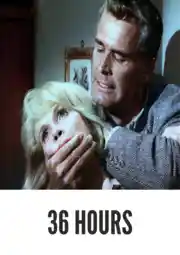Contact: [email protected]
Video Sources 0 Views

Synopsis
[ez-toc]





Introduction
The world of cinema, once confined to the nuanced beauty of black and white, has undergone a transformative journey through the art of colorization. This article embarks on an exploration of this cinematic evolution, with a particular focus on the colorization of the classic film “36 Hours Colorized” (1964). As we delve into the nuances of the colorization process, the importance of preserving old films, and the case study of “36 Hours Colorized,” we witness how the marriage of technology and artistry breathes new life into the cinematic classics of yesteryears.
Read Media File Transfer Agreement: Terms and Conditions
Read FAQ
The Relevance of Colorization in Preserving Cinematic Heritage
Colorization, a controversial yet fascinating technique, has become a pivotal aspect of the film industry’s quest to revitalize old classics. As we unravel the intricacies of this process, it is essential to understand its relevance in preserving the visual legacy of iconic movies. The film “36 Hours Colorized” stands as a compelling example, beckoning us to explore the delicate balance between respecting the past and embracing the future.
The Art of Colorization
Exploring the Colorization Process
Colorizing a black-and-white film involves a meticulous process that seeks to add hues to the monochromatic canvas. From traditional hand-coloring techniques to modern digital methods, this section provides a comprehensive look at the evolution of colorization. The historical significance of Technicolor, a pioneer in color film development, adds a layer of context to the discussion, highlighting how technology has shaped the way we experience cinema.
Aesthetic Nuances: Black and White vs. Color
To understand the impact of colorization, it is essential to delve into the unique aesthetic qualities of black and white photography. This exploration sets the stage for a nuanced discussion on how colorization transforms not only the visual palette of a film but also its emotional and thematic resonance.
Preserving and Restoring Old Films
Valuing Our Cinematic Heritage
Old films are not mere relics of the past; they are cultural artifacts that offer a glimpse into bygone eras and storytelling traditions. This section emphasizes the significance of preserving these treasures and the importance of recognizing them as essential components of our shared cultural history.
Techniques in Film Restoration
The restoration process is a meticulous craft that aims to salvage deteriorating films. From cleaning and repairing physical prints to utilizing advanced digital tools, restorers employ various techniques to breathe new life into classic movies. Understanding these techniques provides insight into the commitment to preserving the integrity of the original works.
The Case Study: “36 Hours Colorized” (1964)
Overview of “36 Hours Colorized”
Directed by George Seaton and featuring a stellar cast including James Garner, Eva Marie Saint, Rod Taylor, and Werner Peters, “36 Hours Colorized” is a war thriller that captivates audiences with its suspenseful narrative and intricate plot twists. The film revolves around Major Jefferson Pike, a key player in a deception operation during World War II, where he finds himself in the clutches of a Nazi spy.
Colorizing a War Thriller: The Creative Choice in “36 Hours Colorized”
The Decision to Colorize
The wartime setting and espionage-laden narrative of “36 Hours Colorized” raise intriguing questions about the decision to colorize such a film. As we explore the creative choices behind this endeavor, we examine how colorization can potentially enhance the immersive quality of war-themed storytelling, making it more relatable to contemporary audiences.
Examining the Colorized Version
Analyzing the Visual Transformation
A critical examination of the colorized version of “36 Hours” unravels the effectiveness of the colorization treatment. Does the addition of color enhance the film’s visual appeal without compromising its original artistic intent? This section delves into the visual nuances, evaluating the success of the colorization process in maintaining the film’s authenticity.
Public Reception and Controversy
Initial Reviews and Legacy
How did the original black-and-white version of “36 Hours” fare with critics and audiences? Were there significant shifts in perception when the colorized version emerged? This section delves into the critical reception of both versions, exploring how the colorization process impacted the film’s legacy.
The Ongoing Debate: Balancing Preservation with Modern Viewing Preferences
The age-old debate between preserving films in their original black-and-white format and embracing colorization persists. Technological advancements now offer viewers the option to choose between the two, allowing a delicate balance between historical authenticity and modern viewing preferences. This section navigates the ongoing dialogue, considering the implications of catering to contemporary tastes while safeguarding cinematic heritage.
Embracing the Past with New Colors: The Significance of Film Colorization
Summing Up the Journey
As we reflect on the transformative journey through the art of colorization, it becomes evident that this technique serves as a bridge between the past and the present. By revitalizing classic films like “36 Hours,” colorization breathes new life into narratives that might otherwise fade into obscurity. The article concludes by emphasizing the importance of this cinematic evolution, offering a renewed appreciation for the timeless tales that shape our cultural tapestry.
In essence, the colorization of “36 Hours” is not merely a technical endeavor; it is a testament to the dynamic nature of cinema—a medium that continues to evolve while honoring its rich legacy. As we embrace the past with new colors, we open the doors to a future where classic films can be experienced afresh, ensuring that the magic of storytelling transcends the confines of time and technology.











